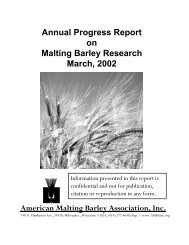Annual Progress Report on Malting Barley Research March, 2007
Annual Progress Report on Malting Barley Research March, 2007
Annual Progress Report on Malting Barley Research March, 2007
Create successful ePaper yourself
Turn your PDF publications into a flip-book with our unique Google optimized e-Paper software.
3.2. A barley nursery composed of differential cultivars will again be evaluated in the<br />
Gallatin Valley and possibly the Flathead Valley of M<strong>on</strong>tana where stripe rust of<br />
barley appeared for the first time in 1996. Commercial cultivars/lines will be<br />
evaluated for stripe rust reacti<strong>on</strong> in areas were the fungus appears naturally.<br />
Virulence types will be compared to stripe rust of barley from other locati<strong>on</strong>s. Wild<br />
grasses will be surveyed for the presence of the fungus as so<strong>on</strong> as the snow cover has<br />
melted and green tissue is visible.<br />
3.3. We maintain several of isolates of Puccinia striiformis hordei, stripe rust of barley,<br />
which have been isolated from the Gallatin Valley over the past few years. These<br />
isolates are periodically increased and purified by single uredosorus isolati<strong>on</strong>. The<br />
virulence will be determined by the reacti<strong>on</strong> of a set of differential cultivars, which<br />
are also maintained at MSU. Inoculum as well as differential cultivars are available<br />
to other research projects at MSU and other locati<strong>on</strong>s worldwide.<br />
Isolates of numerous other barley pathogens are being maintained at MSU. They are<br />
being utilized for class room dem<strong>on</strong>strati<strong>on</strong>, disease screenings and are also<br />
available to other researchers.<br />
4. Results<br />
4.1. F1 populati<strong>on</strong>s from all but a few combinati<strong>on</strong>s of the malting cultivars Metcalfe and<br />
Legacy are now available. Where the seed supply was sufficient an F1 reacti<strong>on</strong> to<br />
stripe rust has been determined <strong>on</strong> 10 seedlings (Tab.1). Most F1 populati<strong>on</strong>s gave, as<br />
expected, a susceptible reacti<strong>on</strong>. Quantitative resistance is usually based <strong>on</strong> a number<br />
of recessive genes. We have l<strong>on</strong>g suspected that Bis<strong>on</strong> 2-22 with high resistance to<br />
barley stripe rust located <strong>on</strong> chromosome 7H is based <strong>on</strong> a mayor gene. F1 results<br />
c<strong>on</strong>firm this hypothesis. Since rust fungi are capable to mutate and overcome<br />
m<strong>on</strong>ogenic resistance rather easily, this gene should not be used by itself, but<br />
combined with other sources. Resistant reacti<strong>on</strong>s could also be observed <strong>on</strong> QTLs<br />
located <strong>on</strong> chromosome 5H indicating some dominance in these loci.<br />
The screened plant have been saved and transplanted. If time allows the first<br />
backcrosses could be made in late spring of <strong>2007</strong>. There is also some left over F1 seed<br />
from all combinati<strong>on</strong> of Metcalfe and Legacy with the resistance d<strong>on</strong>ors.<br />
49
















